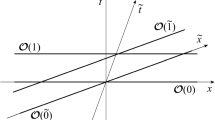Summary
The author suggests a purely algebraic interpretation of interaction. The main idea is to consider interaction as a deformation of an inhomogeneous algebra composed of momentum operators and an arbitrary homogeneous group admitting the equation of the theory. The only difference between this approach and the conventional one is that the generalized momentum operators\(P_\mu \to \partial _\mu - A_\mu ^\alpha \mathop I\limits_\alpha \) do not commute with each other, due not merely to the introduction of some external interaction field, but to the change of the structure of the algebra from which the theory stems.
Riassunto
L’autore suggerisce un’interpretazione puramente algebrica dell’interazione. L’idea principale è di considerare l’interazione come una deformazione di un’algebra inomogenea composta di operatori dell’impulso e di un gruppo omogeneo arbitrario che ammette l’equazione della teoria. L’unica differenza tra questo approccio e quello convenzionale è che gli operatori generalizzati dell’impulso\(P_\mu \to \partial _\mu - A_\mu ^\alpha \mathop I\limits_\alpha \) non commutano l’un l’altro non semplicemente a causa dell’introduzione di qualche campo d’interazione esterna, ma al cambiamento di struttura dell’algebra da cui prende origine la teoria.
Резюме
Автор предлагает чисто алгебраическую интерпретацию взаимодействия. Основная идея состоит в том, чтобы рассматривать взаимлодействие, как деформацию неоднородной алгебры, образованной из операторов импульса и произвольной однородной группы. Единственное различие между этим полходом и общепринятым заключается в том, что операторы обобщенного импульса\(P_\mu \to \partial _\mu - A_\mu ^\alpha \mathop I\limits_\alpha \) не коммутируют друг с другом, что связано не только с введением некоторого внешнего поля взаимодействия, но и с изменением структуры алгебры, из которой следует теория.
Similar content being viewed by others
References
H. Sokolik:Gen. Rel. Grav.,5, 599 (1974).
H. Sokolik:Žurn. Ėksp. Teor. Fiz.,28, 13 (1955).
H. Sokolik:Group-Theoretical Methods in Theories of Elementary Particles (Moscow, 1965, in Russian);H. Sokolik andN. Konopleva:Nucl. Phys.,72, 667 (1965).
R. Penrose:Journ. Math. Phys.,8, 345 (1967).
These ideas were presented byP. Roman at theSymmetries in science, inSymposium Held at Southern Illinois University, Carbondale, 1979.
H. Sokolik andK. Stanukovitch:Group interpretation of the curvature tensor, inProceedings of the GR5 (Tbilisi, 1968).
Author information
Authors and Affiliations
Additional information
Traduzione a cura della Redazione.
Переведено редакцией.
Rights and permissions
About this article
Cite this article
Sokolik, H. Geometrical description of fields. Nuov Cim A 51, 339–344 (1979). https://doi.org/10.1007/BF02776594
Received:
Published:
Issue Date:
DOI: https://doi.org/10.1007/BF02776594




